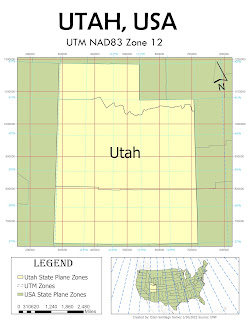This module was extremely helpful, as we dived deep into projection systems. Through the lab, we analyzed UTM, State Plane, Albers and determined when they are the best fit, as well as how to project them properly.
A handful of tools we utilized are listed below:
For our final map, we choose a state in the USA, and determined which projection to use; UTM vs State Plan.
I choose the state Utah because I have always wanted to go
to Zion! I decided not to use the State Plane because there are three different
ones that subdivide the state. Since state plane’s do not work here, I opted
for UTM over Albers because we are looking at a relatively smaller area not
close to the poles. I tried a couple of different UTM NAD83 Zones and landed on
UTM NAD83 Zone 12. In this zone, Utah completely lies within one UTM Zone.

Comments
Post a Comment